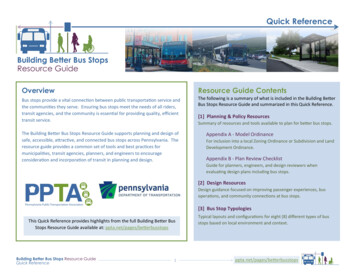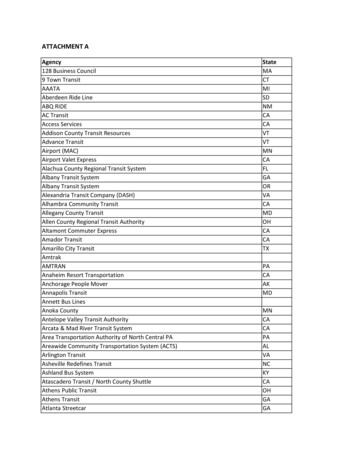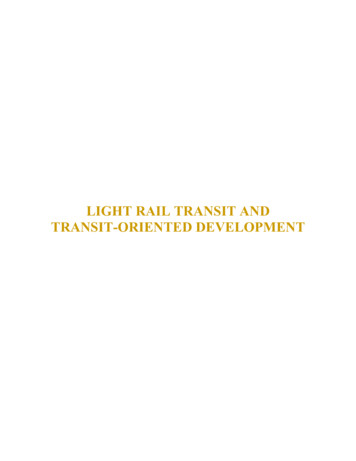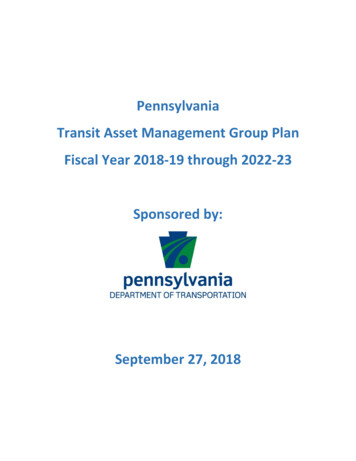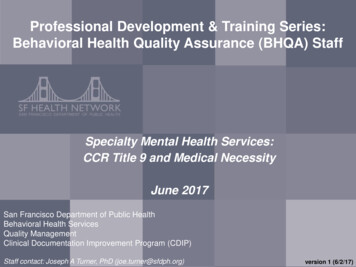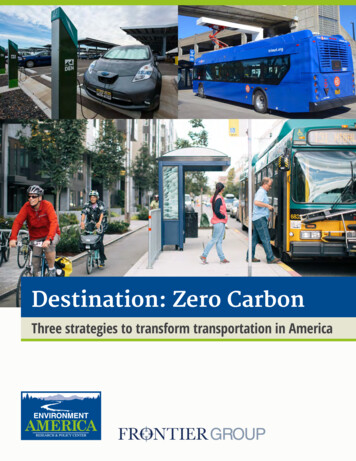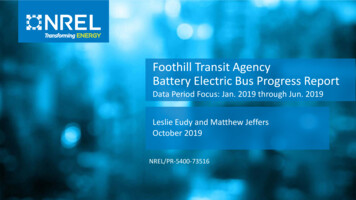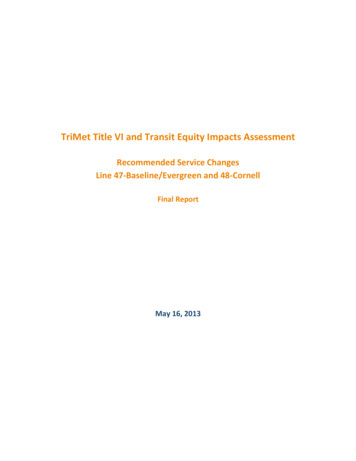
Transcription
TriMet Title VI and Transit Equity Impacts AssessmentRecommended Service ChangesLine 47‐Baseline/Evergreen and 48‐CornellFinal ReportMay 16, 2013
Table of ContentsExecutive Summary.Title VI and Transit Equity Analysis.TriMet System Ridership Profile.Methodology.Analysis of Service Change – Line 47.Analysis of Service Change – Line 48 .Conclusions.Appendix: Line 47 Survey.355711182122List of Figures and TablesFigure 1. Ridership by Mode and Day.Figure 2. 2010 TriMet Service Area Population Race/Ethnic Characteristics.Figure 3. Title VI Assessment – TriMet Service District.Figure 4. Line 47 Potential Route Change.Figure 5. Title VI Assessment and Impacted Stops – Line 47.Figure 6. Line 48 – Proposed Additional Service.Figure 7. TriMet Title VI Assessment: Line 48 ‐ Cornell.Figure 6. Survey Response – Ridership Frequency.Figure 7. Survey Response – Purpose of Trip.Figure 8. Alternative Way to Complete Trip.6710141516202223236Table 1. Ridership by Mode and Day.9Table 2. Alternative Service Availability.Table 3. Available Service Alternatives by Stop and Ridership. 13Table 4. Impacted Line 47 Stops and Ridership Benefitted by Additional Line 48 Service. 16Table 5. Frequency of Service Between NW Stucki and Sunset Transit Center. 17Table 6. Survey Response – Concerns About Service Change. 242
EXECUTIVE SUMMARYThis report evaluates Title VI and transit equity impacts of recommended service changes on Line 47‐Baseline/Evergreen and Line 48‐Cornell in compliance with the Title VI of the Civil Rights Act of 1964 andFTA Circular 4702.1B. The report identifies the presence and magnitude of adverse effects and tests fordisparate impacts (minority) and disproportionate burdens (low‐income) by comparing the percentagesof minority and low‐income populations, respectively, for all impacted census tracts to averages for theTriMet service district.Under TriMet’s policies and definitions, changes on each line would be considered a major servicechange, thus an equity assessment is completed prior to final action on recommended changes.Line 47‐Baseline/EvergreenA routing change for Line 47‐Baseline/Evergreen would impact service at 68 bus stops, including 22stops in minority tracts. The minority population of all impacted tracts is 20.6 percent, less than theTriMet district average (27.1%). There is an adverse effect on service; however this would not be adisparate impact.No impacted stops are located in census tracts where poverty population is higher than the TriMetdistrict average (21.9%).Among all impacted stops there is a high level of alternative service availability, with 92.5 percent ofrider ons and offs either directly served by one or more other lines or within one‐quarter mile or less.Among bus stops in minority tracts, 58.2 percent of impacted ridership would have a high level ofalternative service (46 of 79 daily ons and offs). Added service on Line 48‐Cornell further strengthensavailable alternative service by maintaining am/pm peak frequency at stops presently served by bothLines 47 and 48 along Cornell Rd.Service frequency on Line 47 will be improved, and more frequent service will benefit all trips within theportions of the route illustrated in this analysis, and will benefit midday and evening trips anywhere onthe route. The times of the first trips of the day will be similar to the present, and service will beextended one hour later in the evening for trips to the Hillsboro Transit Center.Onboard surveys were also administered across all trips in the daily schedule along the impacted sectionof Line 47 to generate feedback from the community and assess the impact of the potential routechange on riders’ daily trips. Survey results are provided as an Appendix.A majority of responding riders said they would continue using TriMet service even with changes to Line47. Predominantly, these riders said they would use Line 48 to complete their trip. About 10 percent ofthose surveyed said that they would be without a transportation alternative; these responses generallyalign with results of the stop‐by‐stop analysis of alternative service availability.3
Findings:No Title VI impacts on minority population disproportionate to representation within TriMet’s servicearea were found based on this analysis. Likewise, no disproportionate burden impacts on low‐incomepopulations were found.Adverse effects for impacted riders are highly mitigated by availability of alternative service. Some 93percent of rider ons and offs either directly served by another line or within ¼ mile or less.Line 48‐CornellRecommended changes would be an improvement in weekday service on Line 48. The Line wouldcontinue to run from Hillsboro Transit Center to Sunset Transit Center on its present routing. Therewould be four additional trips daily in each direction along the entire line (from 52 to 60 trips per day).In addition, there will be new trips in the a.m. and p.m. peaks and evening in both directions betweenthe Sunset Transit Center and NW Cornell Rd. at NW Stucki Ave. (21 trips per day). These additional tripswill improve frequency In the Stucki Ave. to Hillsboro TC segment (from 30‐38 minute headways to 15‐17 minute headways) during peak commuting hours and reduce evening headways on the entire Line toto 45 minutes or less from 55‐60 minutes.The first morning trips from Hillsboro Transit Center and Sunset Transit Center would continue run at5:10am and 5:23am, respectively. However, the last trip from Hillsboro Transit Center would be at9:11pm instead of 8:19pm. The last trip from Sunset Transit Center would be at 10:38pm instead of9:54pm.Line 48 riders would benefit from improved frequency and span of service on weekdays. Average dailyridership on Line 48 in Fall 2012 was 970 boardings.Findings:No adverse effects and no Title VI impacts on minority population disproportionate to representationwithin TriMet’s service area were found based on this analysis. Likewise, no disproportionate burdenimpacts on low‐income populations were found.4
TITLE VI AND TRANSIT EQUITY ANALYSISTriMet complies with Title VI of the Civil Rights Act of 1964 and FTA Circular 4702.1B to ensure that: The level and quality of service is provided without regard to race, color or national origin; There is full and fair participation in decision making without regard to race, color or nationalorigin, and; There is meaningful access to programs by persons with limited English proficiency.Definition of Minority and Low‐Income PopulationsFrom FTA Circular 4702.1B“Minority Persons include the following(1) American Indian and Alaska Native, which refers to people having origins in any of theoriginal peoples of North and South America (including Central America), and who maintaintribal affiliation or community attachment(2) Asian, which refers to people having origins in any of the original peoples of the Far East,Southeast Asia, or the Indian subcontinent.(3) Black or African American Populations, which refers to peoples having origins in any of theBlack racial groups of Africa.(4) Hispanic or Latino Populations, which includes persons of Cuban, Mexican, Puerto Rican,South or Central American, or other Spanish culture or origin, regardless of race.(5) Native Hawaiian and Other Pacific Islander, which refers to people having origins in any ofthe original peoples of Hawaii, Guam, Samoa, or other Pacific Islands.”For the purposes of this analysis, “low‐income” is defined as a person whose median household incomeis at or below 150% of the federal poverty guidelines as determined by the most recent U.S CensusAmerican Community Survey 5‐year estimatesTRIMET SYSTEM RIDERSHIP PROFILEDaily RidershipThe following data plotted in Figure 1 below illustrate the distribution of ridership between TriMet’s busand rail systems on weekdays, Saturday, and Sunday. Ridership data is collected on an on‐going basis viaAutomatic Passenger Counters (APCs) on TriMet vehicles and summarized quarterly. The data in Table 1is from the Fall 2012 summary period.5
Table 1. Ridership by Mode and DayService *Rail includes both MAX light rail and WES commuter railFigure 1. Ridership by Mode and 00200,000100,0000WeekdaySaturdaySundayRace and Ethnicity – Service Area ProfileBased on 2010 Census data 27.1 percent of the population within TriMet’s service district is consideredminority using the definition provided in the FTA Circular 4702.1B. As shown in Figure 2, minoritypopulation within TriMet’s service district includes Hispanic or Latino (12.1%), Asian (7.0%), Black orAfrican American (3.5%), American Indian or Alaskan Native (0.6%), Native Hawaiian or Other PacificIslander (0.5%), Two or More Races (3.3%) and Other (0.2%).6
Figure 2. 2010 TriMet Service Area Population Race/Ethnic Characteristics0.6%3.5%3.3%0.5%0.2%White Non‐Hispanic (NH)Hispanic or Latino7.0%Asian (NH)Black/African American (NH)12.1%Two or More Races (NH)American Indian/Alaskan Native(NH)72.9%Native Hawaiian/Other PacificIslander (NH)Other (NH)Income – Service Area ProfileBased on the 2007‐2011 US Census American Community Survey 5‐year estimate, 21.9 percent of thepopulation within TriMet’s service district is considered low‐income (person whose median householdincome is at or below 150% of the federal poverty guidelines).METHODOLOGYDefinition of Major Service ChangeTriMet will consider any service changes that qualify for a public hearing under TriMet Code, Section18.15 as a “major service change” and in need of analysis under Title VI. Service changes that require apublic hearing are as follows:1. A change in service of:a) 25% or more of the number of transit route miles, or;b) 25% or more of the number of transit revenue vehicle miles of a route on a daily basis forthe day of the week for which a change is made, or;2. A new transit route is established.7
Quantification of ImpactsRidershipTriMet regularly collects passenger boarding and alighting data via Automatic Passenger Counters (APCs)installed on many of its buses and rail cars. Every trip is sampled multiple times during each quarterlyservice period resulting in passenger activity data available at the stop level and aggregated quarterly.This quarterly collection of ridership data is the Passenger Census. This analysis uses Passenger Censusdata from the Fall 2012 quarter. For route changes, ridership (ons and offs) at bus stops on the affectedroute segment(s) is used.Minority and low‐Income PopulationsCensus tract level data is utilized for this analysis. The following data tables were used:Minority: T55. HISPANIC OR LATINO ORIGIN BY RACE, 2010 CensusPoverty: T117. RATIO OF INCOME TO POVERTY LEVEL, 2007‐2011 American Community Survey5‐Year EstimatesIdentification of Impacted Census Tracts and Disproportionate ChangesStops associated with route segments that have potential changes are considered impacted. Any tractcontaining an impacted stop is considered impacted. If the percentages for impacted minority and/orlow‐income populations within the impacted tracts exceed those of the District as a whole, the impactof changes to the route will be considered disproportionate.TriMet service area thresholds for sensitive Income21.9%Figure 3 shows census tracts within the TriMet service and indicates those that are above the minorityand/or low‐income threshold.Defining Alternative Service AvailabilityIn addition to considering impacts, this analysis will also identify the extent to which there is alternativepublic transportation service available. Alternative service availability will be rated as fully covered, high,8
medium or low according to the criteria described in Table 2. Alternative service is assessed for eachstop that Line 47 would no longer serve in the event of the routing change and does not include stopsthat will be unaffected by the potential route change. Alternative service includes other transit linesdirectly serving the stop or within ½ mile or less walking distance. For a portion of trips the use ofalternative service would include the need to transfer.Table 2. Alternative Service AvailabilityLevel of Alternative Service Available For Impacted StopsFully Covered(All impacted stops directly served by one or more other lines, with similar span of service.)High(Alternative service within ¼ mile or less walking distance for 75% or more of impacted boardings and alightings.)Medium(Alternative service within ½ mile or less walking distance for 50% of impacted boardings and alightings.)Low(Alternative service greater than ½ mile or less walking distance for 50% of impacted boardings and alightings.)9
02.5Bus LinesMiles57.510Title VI Poverty (21.9% or Greater)Title VI Minority (27.1% or Greater)Title VI Minority and PovertyTriMet DistrictTriMet Title VI AssessmentTriMet Service DistrictFigure 3O
ANALYSIS OF SERVICE CHANGE – LINE 47OverviewTitle VI and Transit Equity ImpactsLine 47‐Baseline/Evergreen’s potential route change does impact stops in some census tracts withminority populations higher than the TriMet district average. The minority population of all impactedtracts is 20.6 percent which is less than the TriMet district average of 27.1 percent. No impacted stopsare located in a census tract where poverty population is higher than the TriMet district average orwhere poverty and minority populations are higher than the TriMet district average. A majority of theimpacted stops (67.6%) are located in non‐minority, non‐poverty census tracts (tracts with povertylevels and minority population below the TriMet district average). (See Figure 5). Based on this analysis,there is an adverse effect on some riders but not a disparate impact on minority populations.Access to AlternativesOverall, a majority of the impacted stops (77.9%) and ridership (92.5%) are within a ¼ mile of analternative route; and, only six percent of the stops and 0.5 percent of the ridership are more than ½mile from an alternative route (Table 3). Though not all stops are within ¼ mile of alternative service,over 90 percent of the impacted boardings and alightings are within ¼ mile of an alternative, so there isa high level of alternative service availability.Twenty‐two of the impacted stops are located in census tracts where the minority population share isgreater that the TriMet district average. Of these, about three‐quarters (72.7%) of the stops are lessthan on‐quarter mile from alternative service. Of the total ridership at those stops, 58 percent is withinone‐quarter mile of alternative service. The remaining 46 impacted stops are located in census tractswhere the poverty level and minority population share are both less than the TriMet district average. Ofthese stops, 80 percent are within a quarter mile of alternative service as is 97 percent of the ridership.(See Table 3).Service ChangesRouting: Line 47 would run from Hillsboro Transit Center to Portland Community College (PCC) RockCreek Campus instead of going to Sunset Transit Center. This routing change would create a newconnection between the Bethany area and Hillsboro Transit Center (See Figure 4).Frequency: Service frequency on Line 47 will be improved, and more frequent service will benefit alltrips within the portions of the route illustrated in this analysis, and will also benefit midday and eveningtrips anywhere on the route. Service in am/pm peak hours between PCC Rock Creek and Orenco/NW231st Ave will be every 15 minutes, compared to current service about every 30 minutes. Midday servicewould not change, with service every 35 minutes along the entire route. Evening service would runabout every 30 minutes, an improvement from about every 60 minutes currently.11
Span: The times of the first trips of the day will be similar to the present, and service will be extendedone hour later in the evening for trips to the Hillsboro Transit Center.Ridership ImpactsLine47Route changeOnsOffsTotal315349664Demographic ImpactsAll Impacted Tracts ‐Current Line 47 RouteLine47Route PovertyThreshold20.627.1%5.4%21.9%Available Service AlternativesThere is a high level of alternative service availability (Table 3 and Figure 5). Bus stops on portions ofCornell Road, Cedar Hills Blvd. and Barnes Road that would no longer be served by Line 47 wouldcontinue to be covered by Line 48‐Cornell. Table 3 enumerates the available service alternatives stop‐by‐ stop and ridership for impacted stops only, which generally includes stops on and to the east of NW185th Avenue. Seventy‐eight percent of impacted stops (53 of 68) are within ¼ mile or less of alternativeservice. Only four stops are more than ½ mile from alternative service. These stops are in non‐minority,non‐poverty census tracts (Figure 5). Though some stops are beyond ¼ mile of alternative service, over92 percent of the impacted boardings and alightings (614 of 664) are within ¼ mile of an alternative(Table 3 following).12
Table 3. Available Service Alternatives by Stop and 12.6%7911.9%Alternative ServiceLess than ¼ MileBetween ¼ and ½ MileGreater than ½ Minority & Poverty00%00%00%00%Non‐Minority, ative ServiceLess than ¼ MileBetween ¼ and ½ MileGreater than ½ 0%664100%Alternative ServiceLess than ¼ MileBetween ¼ and ½ MileGreater than ½ .0%7.4%0.6%61447392.5%7.1%0.5%thNOTE: Some currently served rides to/from locations east of 185 may require a transfer with implementation of the potentialchange to Line 47.13
JACKSON SCHOOLBROOKWOOD10THBASELINECORNELLTriMet Title VI AssessmentMAINSHUTE0Miles1TriMet District2Available Alternative SerivceDiscontinued SegmentProposed Line 47Proposed Change and Alternative ServiceLine 47 ‐ UNSET185THPCC Rock CreekLAWCORLAIDNELLBETHANYTriMet Service District ��SUNSETHWBARNESCEDARHILLSOBALTICFigure 4158THKAISERMURRAY143RDALOCLEKCORNELIUS PASS
UNSET158THPCC Rock AYCEDARHILBARNESLSTHOMPSONHWY217‐SU TCNSETE 3RD0Title VI Poverty (21.9% or Greater)Title VI Minority (27.1% or Greater)Title VI Minority and PovertyTransit CenterMiles0.9Data: TriMet, US Census BureauTCOther Bus LinesGreater than 1/2 MileBetween 1/4 and 1/2 MileLess than 1/4 MileAlternative Stop Walking DistanceAvailable Alternative SerivceDiscontinued SegmentProposed Line 4747 ‐ Baseline/EvergreenTriMet Title VI Assessment1.8Figure 5
Other Mitigation – Changes on Line 48-CornellService changes are also recommended on Line 48-Cornell including added weekday trips and serviceending about 45 minutes later in the evening. During am and pm peaks there would be more tripsbetween NW Stucki Place and the Sunset Transit Center where segments of the present Line 47 overlapsthe Line 48 routing (Figure 6). (See Equity Analysis – Line 48 for more detail.)More frequent service on Line 48 would provide additional alternative service at 31 of the 68 stops onLine 47 impacted by the Line 47 routing change. This added service on Cornell would offer increasedalternative service for approximately 68 percent of total ridership impacted by the Line 47 routingchange (Table 4).Table 4. Impacted Line 47 Stops and Ridership Benefitted By Additional Line 48 ServiceLine 47 Impacted Stops and Rides thatwould benefit by Line 48-CornellimprovementsAll Line 47 Impacted Stops and 966416
There would be more frequent service in the am/pm peaks under the proposed change and during theevenings (Table 5).Table 5. Frequency of Service Between NW Stucki and Sunset Transit CenterCurrentCurrentProposed(Line 47 Only)(Lines 47 and 48 sharedsegments)(Line 48 Only)AM Peak 40PM Peak (4‐6 pm)36‐3819‐2016‐175520‐45*30‐45*Headways by PeriodEvening*45 minutes after 9:00pmThis additional Line 48 service would directly respond to rider feedback expressed in the Line 47passenger survey (see Appendix). Of those surveyed, 76 percent said that they would adjust to the Line47 route change by taking another transit line, and 62.1 percent would be choosing the Line 48 as theiralternative route. This finding supports the idea that, if Line 47 changes its route, there will be additionaldemand for service on Line 48. Furthermore, 75 percent of those surveyed were commuting to work,which suggests that a substantial share of impacted trips along the route is within peak commutinghours.17
ANALYSIS OF SERVICE CHANGE – LINE 48Title VI and Transit Equity ImpactsCensus tracts served by Line 48 have minority population of 35.1%, above the district average of 27.1%.The Line serves tracts with a poverty population 20.0%, somewhat below the district average of 21.9%.Based on the analysis of proposed changes, no Line 48‐Cornell riders would be adversely affected. Inthe absence of adverse effect there is no disproportionate impact. Likewise, no disproportionate burdenimpacts on low‐income populations were found. The benefits of improved service would generally beavailable to populations including protected populations in areas served by Line 48.Service improvements in the segment between the Sunset Transit Center (STC) and Cornell Rd. at NWStucki Ave. would include: Frequency: additional trips during a.m. peak, p.m. peak and evening, with a.m./p.m. peak headwaysgoing from 30/36 mins. to 15/16 mins. and evening headways going from 55 to 30‐45 mins. Span : the last trip of the day in each direction would be about 50 minutes later than at present.Service improvements in the segment between Cornell Rd. at NW Stucki Ave. and Hillsboro TransitCenter (HTC) would include: Frequency: additional trips during p.m. peak and evening, with p.m. peak headways going from36/38 mins. to 32/34mins. and evening headways going from 55 to 30‐45 mins. Span: the last trip of the day to STC would be about 50 minutes later than at present.Figure 7 indicates the portion of Line 48 between NW Stucki Ave. and the Sunset Transit Center thatwould receive most of the additional trips and the demographic make‐up of the area Line 48 serves.Service Changes:Line 48 would continue to run from Hillsboro Transit Center to Sunset Transit Center on its presentrouting. However, Line 48 will make 4 additional trips in each direction along the entire line (from 52 to60 trips per day). In addition, there will be new trips in the a.m. and p.m. peaks and evening in bothdirections between the Sunset Transit Center and NW Cornell Rd. at NW Stucki Ave. (21 trips per day).These additional trips will double the frequency (from 30‐38 minute headways to 15‐17 minuteheadways) during peak commuting hours and reduce evening headways to 45 minutes or less where itcurrently averages 55‐60 minutes.Weekday: The first morning trips from Hillsboro Transit Center and Sunset Transit Center wouldcontinue run at 5:10am and 5:23am, respectively. However, the last trip from Hillsboro Transit Centerwould be at 9:11pm instead of 8:19pm. The last trip from Sunset Transit Center would be at 10:38pminstead of 9:54pm.18
In the Sunset TC to Stucki Ave. segment, frequency during the peaks (defined as 7:00am‐9:00am and4pm‐6:00pm) would be increased so that buses run every 15‐20 minutes instead of every 30‐40minutes. Mid‐day frequency remains at 35‐40 minutes. With the added trips, frequency in the eveningis 30‐45 minutes; whereas, currently, trips after 6pm only run about every 55‐60 minutes.In the Stucki Ave. to Hillsboro TC segment frequency during the p.m. peak and evening would beimproved to every 32‐34 mins. from every 36‐38 and evening frequency would be every 30‐45 minutes.Line 48 riders would benefit from improved frequency and span of service on weekdays. Average dailyridership on Line 48 in Fall 2012 was 970 boardings.19
5THMAINTitle VI Poverty (21.9% or EAMBERBASELINEALOCLEK209THCORNELIUS N VALLZELEYHABROOKWOODTitle VI Minority (27.1% or Greater)Title VI Minority and PovertyBURKHAData: TriMet,LTE US CensusR0CHWITProposedAdditional ServiceHillsboroTCTC Transit CenterLine 48Line 48 ‐ CornellTriMet Title VI AssessmentOAKJACKSON SCHOOLBASELINEJACKSON SCHOOL10TH1STHILLSBOROMEEKMURRAYILLSCEDARHTCROOD BRIDGEBEAVERTON Y 217Figure 7175THRRYES FECOENLG217SCHOLLKAISERYHWRIVER
CONCLUSIONSLine 47‐Evergreen/BaselineConsidering recommended changes for Line 47, no Title VI impacts on minority populationdisproportionate to representation within TriMet’s service area were found based on this analysis.Likewise, no disproportionate burden impacts on low‐income populations were found.The recommended routing change for Line 47‐Baseline/Evergreen would impact service at 68 bus stops,including 22 stops in minority tracts. This creates an adverse effect on service at some stops includingstops in minority tracts; however, it is not a disparate impact. The percentage of minority populationamong all impacted tracts (20.6 percent) is below the threshold for the TriMet district (27.1%).In general, most adverse effects for impacted riders are mitigated by alternative service availability.There is a high level of alternative service availability, with some 93 percent of rider ons and offs eitherdirectly served by another line or within ¼ mile or less.Among bus stops in minority tracts, 58 percent of impacted ridership would have a high level ofalternative service availability (46 of 79 daily ons and offs). All of the remaining ridership in minoritytracts (33 daily ons and offs) would have alternative service available between ¼ and ½ mile.Added service being recommended on Line 48‐Cornell would further reinforce mitigation, resulting inservice at impacted stops on Cornell (presently served by Lines 47 and 48) as frequent or better duringam/pm peak periods and improved in the evening over present schedules.It should also be noted that the new alignment for Line 47 would add service and benefit tracts with anabove‐average concentration of minority population (35.9%) relative to the TriMet district average of27.1 percent. The revised routing would provide new connectivity between the Hillsboro Transit Centerand the Bethany area and Portland Community College at Rock Creek, expected to serve increasedridership overall and benefit all populations along the entirety of Line 47.Line 48‐CornellBased on the analysis of proposed changes, no Line 48‐Cornell riders would be adversely affected. Inthe absence of adverse effect there is no disproportionate impact. Likewise, no disproportionate burdenimpacts on low‐income populations were found. The benefits of improved service would generally beavailable to populations including protected populations in areas served by Line 48.21
APPENDIXLine 47 – SurveyPassenger intercept surveys were conducted on Line 47 along the impacted area. Passengers were askedto answer eight questions about their starting point, destination, purpose, extent to which they wouldbe affected by the Line 47 route change, and possible alternatives if that change occurred. In total 190riders were surveyed over three days at which point surveyors were starting to encounter people theyhad already surveyed.ResultsOf the 190 riders surveyed 61 percent reported that the ride the bus every day and 75 percent werecommuting to work (Figures 8 and 9).Figure 8. Survey Response – Ridership Frequency6%n 1908%Every DayCouple Times per Week24%Few Times per Month61%Less than once per Month22
Figure 9. Survey Response – Purpose of Trip6%9%n 190Work12%SchoolShop75%Other35%NOTE: Respondents were able to specify more than one reason for riding, so total may sum more than 100%In response to Question 6: “Due to low ridership, TriMet is considering changing this line so it doesn’tserve this ar
TriMet will consider any service changes that qualify for a public hearing under TriMet Code, Section 18.15 as a "major service change" and in need of analysis under Title VI. Service changes that require a public hearing are as follows: 1. A change in service of:


